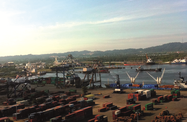Sarawak is investing heavily in improved transport links as energy and investment projects crucial to national development get into gear. However, plans for a statewide railway connection have stalled over viability concerns.
In February, local authorities announced that the construction of a 32-km road linking the district capital of Belaga with Menjawah was ahead of schedule. Though it makes up only a fraction of the road network planned for the state, the road will be a crucial link in connecting the Bakun hydroelectric dam to the outside world when it is completed in August 2013.
Plans are under way to build a total of 2819 km of roads in Sarawak under the 10th Malaysia Plan. Sarawak was also allocated RM2bn ($654m) to build new roads for a three-year period beginning in 2010 as one of the Government Transformation Programme’s (GTP) Rural Basic Infrastructure National Key Result Areas. Meanwhile, the state's transport and storage subsector is expected to expand by 4.7% in 2012, owing to healthy external demand from regional economies.
In February it was announced that RM423m ($138.4m) would be spent over the next three years to upgrade the 2333-km Pan Borneo highway connecting Sarawak to Sabah. Additionally, last November the government confirmed the budget for two other major road projects, with RM90m ($29.5m) allocated to the Kapit-Song Road and RM62m ($20.3m) to the Belaga Town-Bakun road.
The links will become more important as major projects such as the Bakun Dam and the Sarawak Corridor of Renewable Energy (SCORE) come on-line. While the dam is expected to have a capacity of 2400 MW by 2014, regional economic zone SCORE aims to attract investors with rich energy resources – 20,000 MW will be made available through hydropower and 3000 MW through other energy sources, including biofuels.
Mid-2011 saw the completion of an 88-km road connecting Sibu, the biggest town and an important transport centre for goods, to the Tanjung Manis deep-water port, as well as to Matu, Daro, Meradong, Belawai and Sarikei.
“The potential for these towns in the central region to become new centres of growth is tremendous thanks to this improved connectivity,” Michael Manyin Jawong, the minister of infrastructure development and communications, told OBG. "Aside from the construction of additional roads, the new industries will also require the support of upgraded roads so that they can handle the tonnage that will begin to pass through the SCORE region."
According to local officials, RM1.5bn ($495.5m) has been approved to be spent on nine priority infrastructure projects that will facilitate SCORE. These include proposed access road projects to Murum, Nanga Merit, Baram, Baleh, Tunoh, Limbang, Samalaju Industrial Park and the new Mukah Airport. Designed to attract projects that consume significant amounts of energy, such as aluminium smelting, iron and steel, and glass manufacturing, SCORE had received RM28bn ($9.2bn), with another RM70bn ($23bn) worth of projects proposed by August 2011.
As the development of the state's road network continues apace, plans for better rail and air links are also under way. In December, the deputy transport minister, Datuk Abdul Rahim Bakri, pledged that the government would not neglect the state's air connectivity, adding that a RM136.8m ($44.8m) expansion of Sibu Airport was on schedule to be completed in September 2012. National airline Malaysia Airlines (MAS) operates flights from KIA to Singapore, Bandar Seri Begawan in Brunei Darussalam and Hong Kong (via Kota Kinabalu in Sabah), while rural links are available to Miri, Sibu and Bintulu.
While most international visitors to the state arrive at Kuching International Airport, officials say air access to SCORE will be improved by 2014 through upgrades to Mukah Airport, with RM300m ($98.2m) to be spent on improving facilities and enabling the runway to handle Boeing 737s.
There are also plans to build a 320-km railway track between Similajau in Bintulu Division and the Tanjung Manis industrial port, with officials predicting that the port should see around 5m tones of cargo movement annually by 2020. However, Sarawak’s minister of infrastructure development and communications, Dato Sri Michael Manyin Jawong, told local media last July that the project would be unable to cater to passengers, due to the costs involved.
Offering a greener alternative to more modern forms of transport, particularly for state capital Kuching, is the state's 3300-km network of navigable rivers. In 2008 the UN Development Programme conducted a study of the state’s waterways, which resulted in the development of an Inland Waterway Transport (IWT) Master Plan. The plan runs up to 2020 and focuses on building up IWT and community water transport, along with creating an institutional framework for the Sarawak Rivers Board.

